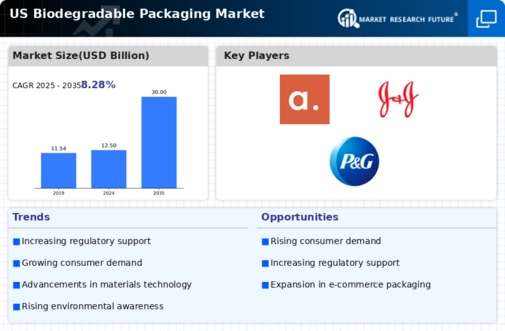Increasing Environmental Awareness
The biodegradable packaging market is experiencing growth driven by heightened environmental awareness among consumers. As individuals become more conscious of the ecological impact of plastic waste, they are increasingly seeking sustainable alternatives. This shift in consumer behavior is reflected in market data, indicating that approximately 70% of consumers in the US prefer products with eco-friendly packaging. Companies are responding to this demand by investing in biodegradable materials, which not only meet consumer expectations but also enhance brand loyalty. The biodegradable packaging market is thus positioned to benefit from this trend, as businesses strive to align their practices with the values of environmentally conscious consumers.
Government Regulations and Policies
The biodegradable packaging market is significantly influenced by government regulations aimed at reducing plastic waste. Various states have implemented policies that encourage or mandate the use of biodegradable materials in packaging. For example, California has enacted laws that restrict single-use plastics, thereby creating a favorable environment for biodegradable alternatives. This regulatory landscape is expected to drive market growth, as companies seek compliance while also appealing to eco-conscious consumers. The biodegradable packaging market stands to gain from these initiatives, as businesses adapt to meet new legal requirements and consumer preferences.
Corporate Sustainability Initiatives
Many corporations in the US are adopting sustainability initiatives that prioritize the use of biodegradable packaging. This trend is driven by a combination of consumer demand and regulatory pressures. Companies are increasingly recognizing that sustainable practices can lead to cost savings and improved brand reputation. For instance, a report indicates that businesses utilizing biodegradable packaging can reduce their carbon footprint by up to 30%. As a result, the biodegradable packaging market is likely to see increased investment from corporations aiming to enhance their sustainability profiles and meet the expectations of environmentally aware consumers.
E-commerce Growth and Packaging Needs
The rise of e-commerce in the US is creating new opportunities for the biodegradable packaging market. As online shopping continues to grow, the demand for sustainable packaging solutions is increasing. E-commerce companies are under pressure to reduce their environmental impact, leading to a shift towards biodegradable options. Market data suggests that the e-commerce sector is projected to reach $1 trillion by 2025, with a significant portion of this growth driven by consumer preferences for eco-friendly packaging. Consequently, the biodegradable packaging market is poised to benefit from this trend, as businesses seek to align their packaging strategies with the sustainability expectations of their customers.
Innovation in Biodegradable Materials
Advancements in material science are propelling the biodegradable packaging market forward. Researchers and companies are developing innovative materials that offer enhanced performance while being environmentally friendly. For instance, new bioplastics derived from renewable resources are being introduced, which can decompose more efficiently than traditional plastics. This innovation is crucial, as it addresses both consumer demand for sustainable options and the need for effective packaging solutions. The biodegradable packaging market is likely to expand as these new materials become commercially viable, providing businesses with more choices to meet sustainability goals.














Leave a Comment